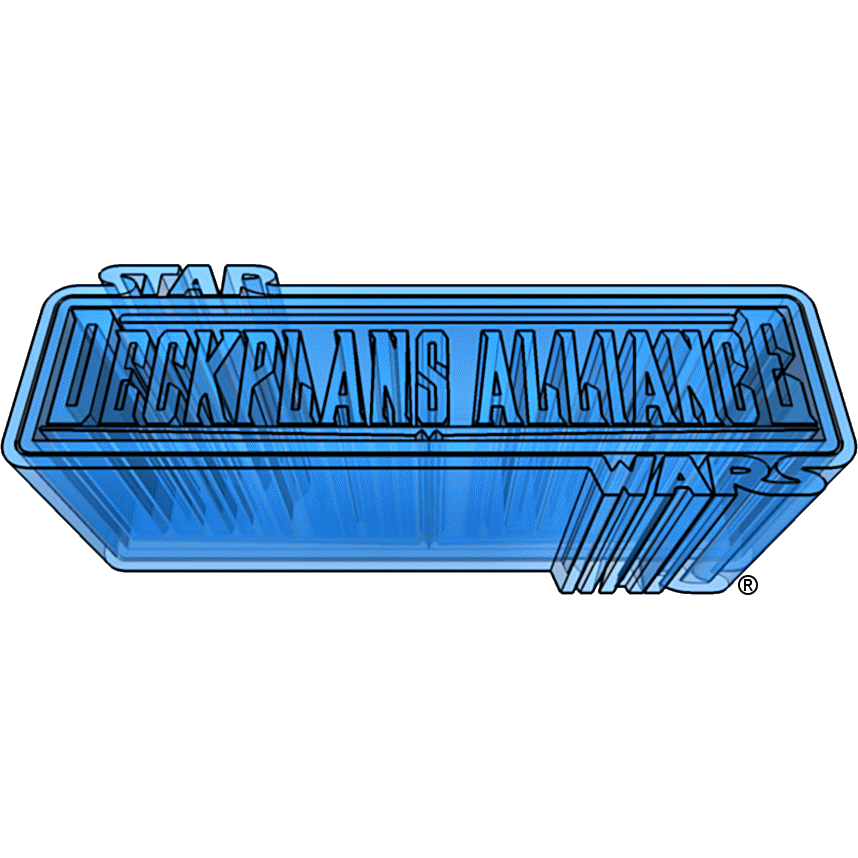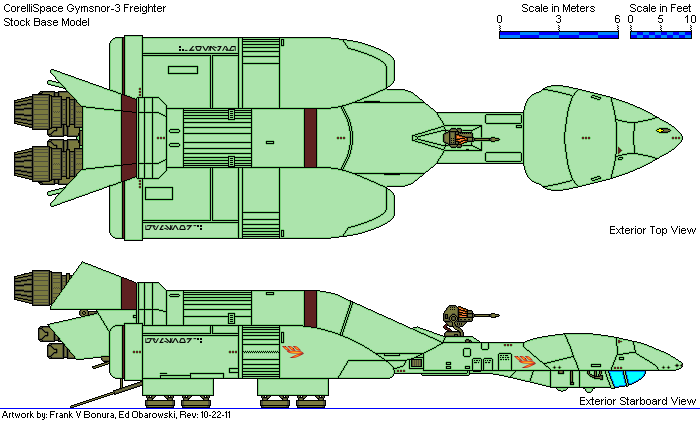

A joint-effort space transport project developed by Frank V Bonura, with help from Ed Obarowski. The Exterior of the ship is mainly based on the drawings, of Bob Caswell from, “Galaxy Guide 6 - Tramp Freighters” (First Edition page 37, Second Edition page 86) and with additional design influences from 3D CGI artist David Pilurs from “The Star Wars® Adventure Journal (Vol. 1, Number 9, page 57), both published by West End Games.

Capsule: An ambitious failure, the Gymsnor-3 was one of CorelliSpace's attempts to challenge Corellian Engineer's grip on the light freighter market. The Gymsnor series is little seen outside Corellian space.
— “Star Wars® - Pirates & Privateers”, p. 63
Gymsnor-3 Light Freighter
— “Star Wars® - Pirates & Privateers”, p. 62
- Craft: CorelliSpace Gymsnor-3 Freighter
- Type: Light freighter
- Scale: Starfighter
- Length: 34.1 meters
- Crew Skill: Space transports: Gymsnor-3 freighter
- Crew: 1
- Crew Skill: Varies widely
- Passengers: 4
- Cargo Capacity: 195 metric tons
- Consumables: 1 month
- Cost: 72,000 (new)1, 19,000 (used)
- Hyperdrive Multiplier: x2
- Nav Computer: Yes
- Maneuverability: 1D
- Space: 4
- Atmosphere: 280; 800 kmh
- Hull: 5D
- Shields: 1D
- Sensors:
- Passive: 15/0D
- Scan: 30/1D
- Search: 45/2D
- Focus: 3/3D
- Weapons:
- Laser Cannon
- Fire Arc: Turret2
- Skill: Starship gunnery
- Fire Control: 1D+2
- Space Range: 1-3/12/25
- Atmosphere Range: 100-300/1.2/2.5 km
- Damage: 4D
The ship originally sold for 72,000 credits, but soon proved to be no bargain. Numerous customer complaints included: tight sleeping quarters, poor headroom in the cockpit, poor cockpit visibility, no dorsal entry hatch, no forward cargo loading, no loading crane, no hyperdrive backup, and no inter-ship docking capability. The biggest design flaw was the poor placement of the laser cannon. This factory-installed laser cannon was called the "Deluxe Rock Sweeper", and was designed more for asteroid defense than pirate defense. This cannon could only fire effectively in its forward, port and starboard arcs. The upper deck obstructs most of the lasers rear firing arc creating a defensive blind-spot. Pirates enjoy exploiting this weakness by flying in from the rear and staying very close to the Gymsnor's thrusters where they can pound on the ship's ion drives unmolested.
In the Gymsnor's defense, it should be noted that the ship did have some good features. This ship was designed by CorelliSpace Engineers for safe travel through asteroid fields. Its triple fuselage design makes this ship very rigid and was designed to deflect impacts from solid objects. This coupled with a factory-installed shield generator, make the Gymsnor-3 a survivor in light to moderate asteroid fields. Another survivability feature is that the cockpit command pod serves as an escape pod, so if the main life support system fails, the crew and passengers could retreat to the cockpit and use the escape pod's life support system as a secondary backup. The escape pod can be easily detached and reattached and can be used as a crude shuttle or speeder if needed. For more information see the entry for the CorelliSpace Gymsnor-class escape pod (project under construction).
weapon damagedis rolled, the roll should be rerolled or ignored, at the GM's option. This is because the laser cannon is very difficult to hit from the rear due to the cover provided by the upper hull. If the rerolled result indicates
weapon damagedthen the laser cannon was actually hit in combat.

Internal Layout: The hull of the Gymsnor-3 Light Freighter consists of five structures: a domed command pod, connecting trunk, main fuselage, port outrigger, and starboard outrigger. The main fuselage is the only area of the ship that has two decks.
Command Pod: The lower deck of the command pod houses the ship's cockpit which has only 4 feet of headroom. The cockpit has stations for a pilot, co-pilot, and seating for up to four passengers. All ship functions, as well as the ship's cannon can be Controled from the pilot or copilot position.
Connecting Trunk: The trunk connects the command pod to the main fuselage. The lower main crawl way provides a three foot diameter passage to access the main fuselage and the cockpit. This crawl way is sloped upward slightly from the cockpit to the main deck. There is no artificial gravity in this crawl way. This design is considered an inconvenience because passengers and crew often get filthy crawling through this shaft. This was yet another bad selling point.
Main Fuselage: The lower deck of the main fuselage has up to 6 feet of head room. The lower deck houses some weapon management systems, housed in two compartments at the very front. Behind the weapon management systems is the ship's galley (kitchen) on the starboard side and the ship's head (bathroom) on the port side. The bathroom (head) contains a sink, toilet, and shower. The Kitchen (galley) contains a lounge with a table, a small pantry, and a food processor. Behind the galley / head is the ship's cargo hold which takes up the bulk of the lower deck. Aft of the hold, is the entrance ramp room. This room is a fully working airlock and is suitable for cargo jettisoning (manually or automatic if so equipped), or space walks. At the very rear is the lower engineering room that houses the ship's maneuvering/stabilizer jet systems.
Outriggers: Each consists of one deck with 5 feet of headroom. The outriggers contain the ship's four landing gear assemblies housed in four separate compartments in the floor. These assemblies are not very tall (3 feet) and form raised areas on the floor. Crew and passenger rooms (one of each) are located in the central area of each outrigger. Both of these Crew rooms are identical so they can be assigned to either captain or first mate as desired. Next to the passenger rooms are the ships water storage tanks. At the very front and rear of each outrigger are the ship's fuel storage tanks. Below the fuel tanks under the floor gratings are the ships repulsor generators Controllers and emitters which provide lift for the ship.

The main fuselage is the only area of the ship that has two decks, other areas only have crawlspaces that can be accessed but not entered by human sized technicians. Maintenance droids are better suited to operate in the tight crawl spaces of the Gymsnor-3.
Command Pod: The upper deck of the command pod is only a crawlspace with 2 feet of head room and houses the ship's sensors. The upper crawlspace can be accessed for servicing through a maintenance hatch in the ceiling of the cockpit. The command pod detaches for use as an escape pod so its upper deck also houses consumable tanks for life support and fuel; it also houses two small ion engines, landing gear and maneuvering jets that only function when the escape pod is detached.
Connecting Trunk: The upper crawlspace of the connecting trunk houses the weapon hard point, weapon control system, targeting system, and firing system.
Main Fuselage: The upper deck of the main fuselage has up to 5 feet of head room and can be accessed from the many maintenance hatches in the floor. The ship's forward and flank shield projectors and life support systems are mounted at the very front of the upper deck in the forward mechanical compartment. Behind the forward mechanical compartment is the shield generator compartment. Behind the shield generator compartment is the ship's main engineering room This compartment contains from fore to aft as follows: power core, hyperdrive, ion drive, and thrusters. At the very end, contained in the tail projections are the ship's aft shield projectors.